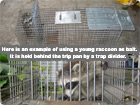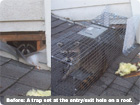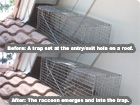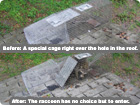Why are there raccoons on the roof? Perhaps they found some food up there, or perhaps they're just curious and want a rooftop stroll, but neither of those is likely.
Most likely, they have found a place to live up there - either some gap under an eave or in a soffit that they can live in, or most likely of all: they've found or torn
open a hole, and are crawling into the attic and living there - that's why raccoons are climbing on your roof all the time.

How to get rid of raccoons on the roof - well, first determine if they're on
the roof in order to get in the attic, and if so, read my raccoons in the attic guide. If not, and they're just crawling or living on the roof, you can trap
and remove them, but be aware that:
1) Raccoons are excellent climbers, so it's fairly difficult to keep them from climbing on the roof. They can ascend the corners of most houses, and easily climb up
and down downspouts. However, if you've got anything
obvious, like a tree right next to the house with branches that overhand the roof, you might want to trim that back. Some people think raccoons can jump on the roof, but that's not really the case. They climb. Read more about Can Raccoons Jump?
2) If they are up there for shelter, you can eliminate debris or gaps under eaves that they like. Get rid of old branches on the roof, and install steel mesh (drill it in) to stop them from accessing gaps.
3) They are most likely up there because they want, or have already found, a way into the attic, so do an full
inspection of the roof and attic to see if there's any evidence of entry.
4) Raccoons can tear open eaves, and even shingled roof, so beware of the damage they are capable of. You'll also find raccoon poop on the roof, so don't step in it or touch it.
5) If you want to trap and remove the raccoons, please be aware that they might have a litter of babies. Look carefully for the young, and if you trap an adult, check for visible nipples, which
indicate nursing baby raccoons.
6) You can set traps on the roof to target the correct animals, but it may be dangerous, you need to set trap backing to protect the shingles, or the raccoons will rip up the shingles. You really have to secure any traps
set on a roof, particularly on a slanted roof (of course, most roofs are slanted). I bolt the traps down with heavy duty screws and washers. Most of all, the raccoon can cook and overheat up there, so be very
vigilant about checking any traps that you set on the roof!
If you want to trap them effectively, click here for a full guide on raccoon trapping tips

You can read more information at this great website: howtogetridofraccoon.com, which is loaded with lots of information.
Also, it might not be a raccoon up there. Learn more about these animals which might be on your roof:
rats in attic -
mice in attic -
possums in attic -
bats in attic
Click below photos for more examples of trap sets by professionals:
- - - - - - - - - - -Below is the longest email I've ever gotten, but it's got some good lessons about raccoons on the roof. For more information about solving raccoon problems, just go to the home page, where you'll see all the information you could ever want about solving a problem with raccoons on the roof and attic. In short:
Dear David,
First of all, I really like your website and all the constructive information you have on it and especially your animal photos! Thank you for sharing so much of your experience in wildlife removal from people’s homes. After reading much of the information on your website, I have decided to write you and ask your advice on the following problem I have been having with a very interesting and in so many ways admirable animal, the RACCOON. I just don’t want to have to share my home with RACCOON any longer, and I am very ready to cut my financial losses due to multiple RACCOON invasions in my attic. I apologize in advance for the length of this email, and hope that you can help me with several questions (see below). My story begins with…..
I live in Arlington, Texas, and I have had a relatively long-term problem trying to get rid of raccoons in my attic. I finally hired a company locally called Critter Company to help me. I liked this company in general after meeting with their field representative because of their understanding of the biology and habits of the raccoons and because they used humane methods to extricate and relocate the raccoons; even though they were relatively expensive for me to obtain their services ($298 for ‘eviction fluid and $298 for first trapped raccoon, plus equivalently priced fees for roof, louver metal screen repairs, etc.). I didn’t see anyway out of having this done properly, so I hired them to help me with my raccoon problem. They placed metal screens over my louvers and fixed a number of holes in my jumbo shake wood roof by placing metal sheets (probably metal flashing) and new shingles where the holes had been. In March they helped me remove a mother with four babies (very noisy family) and about a week later they trapped another young single adult raccoon (not quite as noisy).
About a month later I ended up detecting a second family of raccoons in another part of the attic in the eaves just beside a bedroom near my chimney when outside near the eave and I heard them making a lot of noise during the daytime. Unfortunately, the roof repair and removal job was botched due to the person who was in charge (who I heard later was subsequently fired). He failed to come back and set traps for 2-1/2 days after sealing up a family of raccoons in the attic even though the company kept telling me that he would come since the morning of the day the hole was repaired and no trapping was done until two+ days later. This whole second phase of raccoon removal was a disaster as the repair person had come against my wishes when I was not at home to repair the new hole in the roof. Because the trapper never came back with the traps for the attic, I could hear the raccoons roaming all over the attic scratching and trying to get out those two+ days. Foolishly, someone had left traps on the roof and on the ground, maybe waiting for the field rep to come back and put them in the attic (?)—all to no avail, of course! The raccoons trapped inside evidently made new small holes in my roof and even in the wood leading up to the eaves where it meets the brick in their desperation to get out for food and water, although none of their holes were big enough for them to get out from. Finally, 2-1/2 days later a trap was set and three raccoons were captured. I asked to see them. They looked like three juvenile or older, half-grown raccoons. I think that whole family of raccoons was messed up and separated, as they all were about the same size. None of them appeared to be large enough to be the mother. One of the three wasn’t moving. The Critter Company man first said it was dead, and then told me it was “playing possum.” I wondered at that moment if he told me that just to try to make me feel better. After one more month, I finally had the company come back to repair at least the one hole near the brick the raccoons had pulled inward from the inside. And, indeed, at my request to search for a dead animal I had smelled from one of my bedrooms, they did find and remove a dead young raccoon from the attic.
On my second go-round of attempted raccoon removal, this company did finally tell me that my homeowner’s insurance should cover the damages by wildlife (raccoons) to my house, which it has turned out, because my invaders were considered “wildlife” not rodent pests, my insurance company is responsible for my repairs (less the deductible). I have electrical, insulation replacement, and 3 ceiling drywall repairs needed. Trying to coordinate the work needed between my wildlife company (Critter Company) to get the raccoons finally out and have the roof with no leaks and no new holes and my insurance company (State Farm) and their contracting companies has been complex and very difficult to figure out how to handle for me. Initially, the insurance company wanted to hire regular construction people--not Critter Company, my wildlife expert company--to fix the roof and to put in new insulation, etc., but only after the RACCOONS were gone. Plus, my adjustor wouldn’t come out until the raccoons were gone. I had to explain to the insurance adjustor many times that only after the holes in the roof were repaired would we be able to get and keep the RACCOONS out. What he really wanted was for his companies to do the roof repair work (not Critter Company). So I just had to go with getting that work done first by the Critter Company people on my own. Also, State Farm will pay to replace the insulation, evidently, but their insulation subcontractors don’t know anything about decontamination nor are they licensed or knowledgeable about flea/tick control after the old insulation comes out. I was favoring Critter Company who did quote me for removal and replacement of insulation, plus the decontamination and flea/tick control and a good sprayed R-value(R-39?) insulation since they recognized this needed to be done and this is what they do for their customers. Also, they said that borax would be in the replacement insulation product that they use, which they said was an irritant and deterrent for future wildlife invasion. However, due to gaps in their service before, I am not sure how reliable they will be if I have them do the work.
This week, Round 4, has just happened. I was unable to sleep several nights ago and around 5 am, I heard the gentle pitter patter of feet over my head where I was sleeping. I couldn’t tell if there were RACCOONS on the roof or in the attic so I decided to go try and see if I could see anything outside. Very quietly I went to the back sliding doors, opened them, and stepped outside to see if I could see anything on the roof, and by the time I stepped outside, there were 5 large raccoons on the ground running fast in a scatter pattern away from where they started. I figure I caught them just jumping off and away from the house, but from where, I could not say, of course—probably the roof. An hour later, just before sunrise, I could hear foot patter sounds again over my head nearby and felt like one at least was in the eaves of the attic.
Today, my son and I went into the attic to see if we could identify where the holes in the roof still are (for RACCOONS and/or rain to get through) before I have the other repairs made to the house, and also to see if we could find any RACCOONS sleeping up there. Fortunately, we did not see a RACCOON! He also went onto the roof trying to locate any new holes that might have been created since the Critter Company man was here on July 3 when he found the dead raccoon in the attic eaves. We also tried to see if we could find any holes that match up with where I am having ceiling damage—he looked on the roof while I followed him in the attic. We found relatively small holes (as big as 1 inch by maybe 3-5 inches in size) where the light was coming down onto the insulation. Fortunately, he did not find anymore holes large enough for a raccoon. My son has been looking on the roof since last March and does now know how large the holes have been that the RACCOONS used before they were repaired with each new episode of invasion/detection/removal.
My son thinks that the RACCOONS are only able to get on the roof by jumping from nearby crepe myrtle trees. These trees are very old, probably 50-60 years old, and their strong, thick limbs are much taller than the roof. He has already trimmed away other limbs from a large oak tree and the crepe myrtle limbs that were very close to the roof last April. We are considering severely pruning down these old crepe myrtles so that they are not very tall, and, hopefully, they will survive in this heat, even though pruning time should be January or February. I noticed on your web site that you state that raccoons are very good tree climbers and that RACCOONS can easily get on roofs. The Critter Company rep told me that RACCOONS can climb up the brick walls, and I did see their brown fur markings on white paint near a hole in the wood between the brick and the eaves that the RACCOONS used for attic entry before it was repaired with metal and repainted. The eaves on my house are about three feet wide and my son believes it would be hard for RACCOONS to climb up the brick and then upside down across that much distance across the eaves to reach the edge of the roof to get from the brick to the roof top.
My Questions:
1. Do you think it will help to cut my crepe myrtles very short instead of leaving them very tall to remove access for the RACCOONS to my roof? I would hate to cut them now if it is not going to keep RACCOONS off of my roof anyway!
2. Do you think RACCOONS can get to the roof without tree access?
3. Do you think RACCOONS can jump from the chain length fence to the top of the roof? There is a short (about 3-4 ft high) chain length fence near my house behind the crepe myrtles, probably eight or more feet away from the edge of the roof.
4. Do you think the company your website recommends can help me with my insulation and roof repair problems? I have left them a message to call me tomorrow.
5. Do you think that treating the wood on my jumbo shake roof would act as a deterrent at all for the RACCOONS breaking into my attic? I had this done 5-6 years ago to help preserve the integrity of the wood.
6. My son thinks he can repair the roof in the areas we detected the small holes using metal flashing and new jumbo shake wood shingles. So far, the Critter Company people have not been worried about the rain that is still leaking through my roof, just on keeping the animals out, but I cannot get the other repairs made until there is no more roof leaking. I would love to replace my roof with the metal shingles that resemble what I currently have, which someone told me would be impervious to RACCOONS and any other animals. I have been told by some people that my jumbo shake wood roof will outlast me; however, the RACCOONS seem to have had their way with finding its weaknesses. I cannot currently afford the cost of a new roof, but because the RACCOONS have found many ways in and evidently keep trying to get in, I have wondered if I can ever beat this problem? This is after spending over $2,000 since March to solve these problems!!! Also, I forgot to mention, that there are several acres of unsettled, wooded, creek land half a block away from me, so I imagine there is a never-ending supply of RACCOONS in my neighborhood.
Again, I apologize for the length of my email. If you have stayed with it this far, I really appreciate your reading it to understand my perceived problems!!! I am trying not to be pessimistic about being able to solve my RACCOON problems or how to get my insurance and/or Critter Company Company to best help me. I will truly appreciate any advice that you can offer me.
Sincerely,
Karen
Article about Raccoons in the basement.
Article about Raccoons in the crawl space.
Article about Raccoons in the house or home.
Article about Raccoons in the wall.
Article about Raccoons in the ceiling.
Article about Raccoons in the chimney.
Article topics include:
How to get rid of raccoons on the roof.
Get raccoons off of the roof and keep them off.
How to remove raccoons climbing on the roof.
Wildlife Education - Information, Advice, and Techniques for the Safe Removal of Raccoons from Roof



